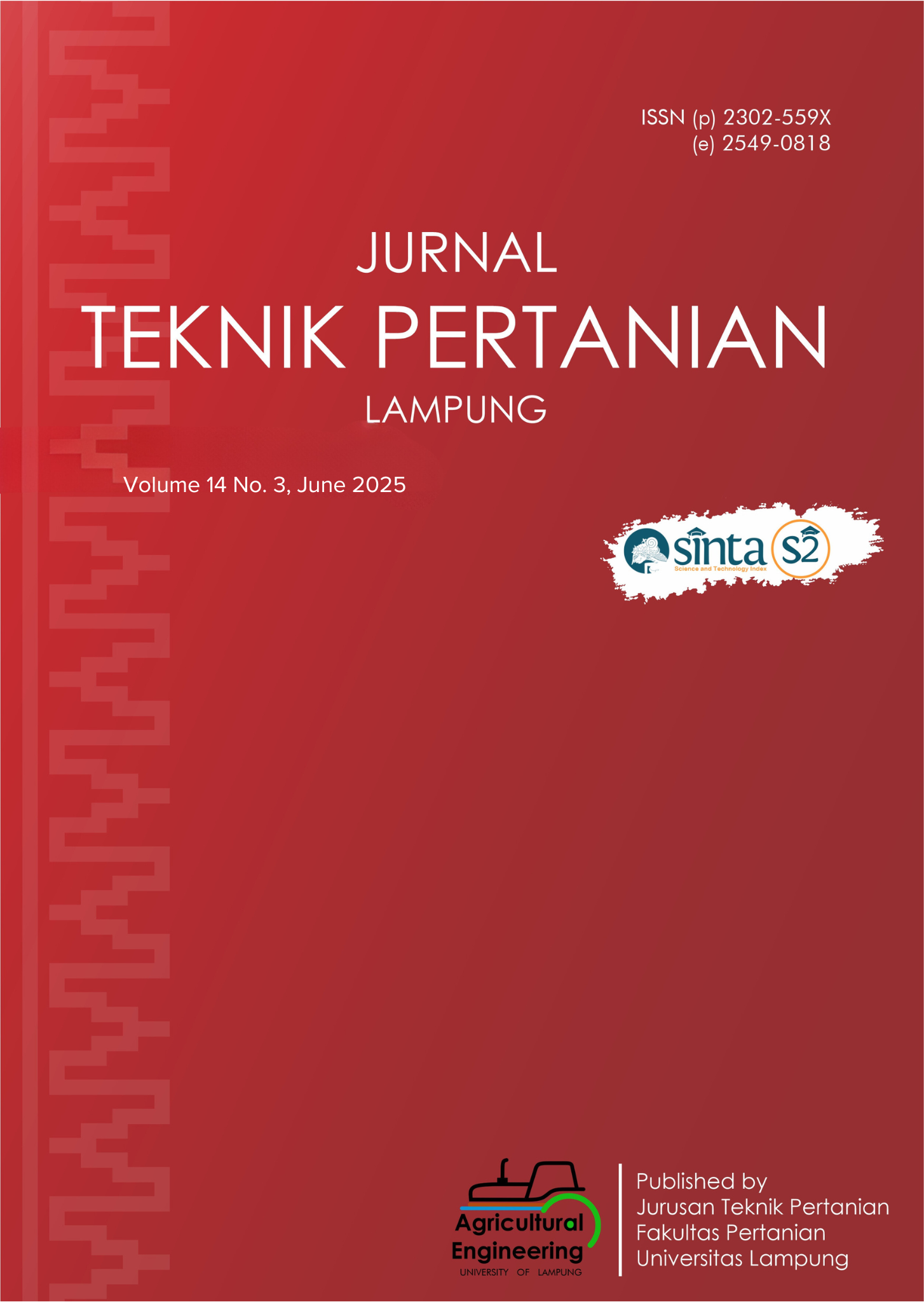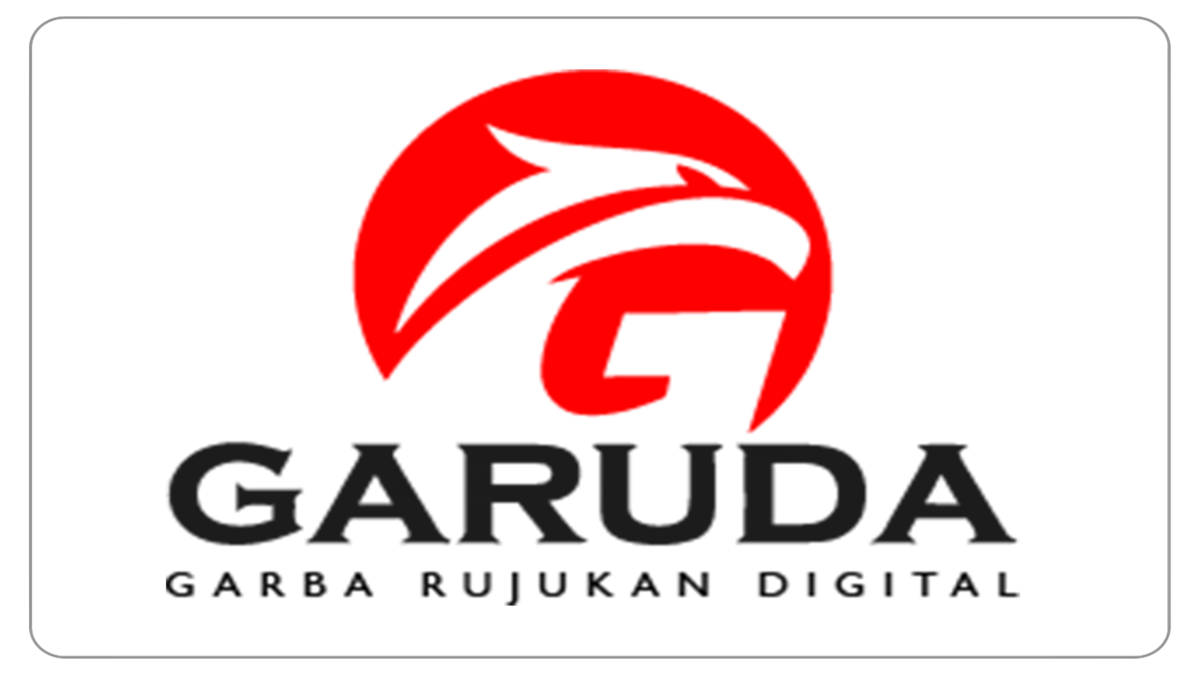Performance of a Moringa Leaf Dehumidification Drying System Using Peltier Effect Thermoelectric Cooling
DOI:
https://doi.org/10.23960/jtep-l.v14i3.1061-1072 Abstract View: 170
Abstract View: 170
Abstract
The study focuses on a drying system that integrates a rack-type convective dryer with a Peltier effect thermoelectric cooler to optimize the drying process of moringa leaves. This system is designed to achieve lower drying temperatures, which is essential for preserving the quality of the leaves. To evaluate the performance of this dryer, researchers use temperature and relative humidity data to construct a programmed psychrometric diagram. This diagram helps in calculating crucial parameters such as the absolute humidity and the specific volume of the drying air. These calculations are essential in determining the drying rate of moringa leaves. The results indicated that moringa leaves dried on drying rack-1 exhibited a higher drying rate compared to those on drying rack-2. Additionally, a drying air speed of 2.1 m/sec yielded a superior drying rate compared to a lower air speed of 1.5 m/sec. After 5.0 hours of drying, the Moringa leaves achieved a moisture content of 8.6% (wb) with a drying air speed of 2.1 m/sec, 9.3% (wb) with a speed of 2.6 m/sec, and 13.9% (wb) with a drying air speed of 1.5 m/sec. The drying process maintains a maximum temperature 59.3°C, placing it within the low-temperature drying category, which helps preserve the physicochemical quality of the dried Moringa leaves.
Keywords: Dehumidification drying, Peltier effect thermoelectric cooling, Moringa leaves, Programmed Psychrometric Calculations.
Downloads
References
Ali, M.A., Yusof, Y.A., Chin, N.L., Ibrahim, M.N., & Basra, S.M.A. (2014). Drying kinetics and colour analysis of Moringa oleifera leaves. Agriculture and Agricultural Science Procedia, 2(March 2015), 394–400. https://doi.org/10.1016/j.aaspro.2014.11.055
Anjorin, T.S., Ikokoh, P., & Okolo, S. (2010). Mineral composition of Moringa oleifera leaves, pods and seeds from two regions in Abuja, Nigeria. International Journal of Agriculture and Biology, 12(3), 431–434.
Anuja, S., & Ramkumar, K. (2017). Effect of various drying methods on the quality of moringa leaf powder (Moringa oliefera Lam.). The Asian Journal of Horticulture, 12(2), 223–226. https://doi.org/10.15740/has/tajh/12.2/223-226
Darvishi, H., Khodaei, J., & Azadbakht, M. (2015). The parameters of mass transfer of convective drying in sliced melon. Philippine Agricultural Scientist, 98(1), 60–72.
Darvishi, H., Mohammadi, P., Azadbakht, M., & Farhudi, Z. (2018). Effect of different drying conditions on the mass transfer characteristics of kiwi slices. Journal of Agricultural Science and Technology, 20(2), 249–264.
Djaeni, M., Utari, F.D., Sasongko, S.B., & Kumoro, A.C. (2018). Evaluation of food drying with air dehumidification system: A short review. IOP Conference Series: Earth and Environmental Science, 102(1). https://doi.org/10.1088/1755-1315/102/1/012069
Djaeni, M., Van Asselt, C.J., Bartels, P.V., Sanders, J.P.M., Van Straten, G., & Van Boxtel, A.J. (2011). Low temperature drying with air dehumidified by zeolite for food products: Energy efficiency aspect analysis. International Journal of Food Engineering, 7(6). https://doi.org/10.2202/1556-3758.1930
Ee, C.T., Khaw, Y.J., Hii, C.L., Chiang, C.L., & Djaeni, M. (2021). Drying kinetics and modelling of convective drying of kedondong fruit. ASEAN Journal of Chemical Engineering, 21(1), 93–103. https://doi.org/10.22146/ajche.62932
Fahey, J.R. (2016). Microbiological monitoring of laboratory mice. Genetically Engineered Mice Handbook, July, 157–164. https://doi.org/10.1201/9781420039078.ch12
Gopalakrishnan, L., Doriya, K., & Kumar, D.S. (2016). Moringa oleifera: A review on nutritive importance and its medicinal application. Food Science and Human Wellness, 5(2), 49–56. https://doi.org/10.1016/j.fshw.2016.04.001
Hasizah, A., Djalal, M., Mochtar, A.A., & Salengke, S. (2022). Fluidized bed drying characteristics of moringa leaves and the effects of drying on macronutrients. Food Science and Technology (Brazil), 42, 1–11.
Jothilakshmi, K., Devipriya, J., & Parvathi, S. (2017). Antioxidant activity Moringa oleifera leaves in different drying methods. Pharmacophore, 8(1).
Kumar, P., Chauhan, N., Singh, B.R., Chandra, S., Singh, J., Mishra, D.K., & Yadav, A.K. (2023). Comparative analysis of the drying properties of moringa (Moringa oleifera L.) leaves, basil leaves and ginger. Pharma Innovation, 12(10), 600–603.
Kurniawan, Y., & Setiawan, A. (2018). Kaji eksperimental dehumidifier portable berbasis termoelektrik dengan variasi arus listrik masukan. JTT (Jurnal Teknologi Terapan), 1(1). https://doi.org/10.31884/jtt.v1i1.32
Lindriati, T., Belgis, M., & Annisafitri, A. (2022). The Application of lamp dryer on production of moringa (Moringa oleifera) leaf flour. Jurnal Pangan Dan Agroindustri, 10(2), 83–92. https://doi.org/10.21776/ub.jpa.2022.010.02.3
Manuwa, S.I., Sedara, A.M., & Tola, F.A. (2020). Design, fabrication and performance evaluation of moringa (oleifera) dried leaves pulverizer. Journal of Agriculture and Food Research, 2(April), 100034. https://doi.org/10.1016/j.jafr.2020.100034
Martínez, K., Talavera, G., & Alonso, J. (2017). Effect of three drying methods on antioxidant efficiency and vitamin C content of Moringa oleifera leaf extract. World Academy of Science, Engineering and Technology International Journal of Chemical and Materials Engineering, 11(12).
Meyer, D., & Thevenard, D. (2019). PsychroLib: a library of psychrometric functions to calculate thermodynamic properties of air. Journal of Open Source Software, 4(33), 1137. https://doi.org/10.21105/joss.01137
Moyo, B., Masika, P.J., Hugo, A., & Muchenje, V. (2011). Nutritional characterization of Moringa (Moringa oleifera Lam.) leaves. African Journal of Biotechnology, 10(60), 12925–12933. https://doi.org/10.5897/ajb10.1599
Munters. (2019). The dehumidification handbook (3rd ed.). Munters Corporation.
Premi, M., Sharma, H.K., Sarkar, B.C., & Singh, C. (2010). Kinetics of drumstick leaves(Moringa oleifera) during convective drying. African Journal of Plant Science, 4(10), 391–400.
Sholikah, P.E.N., Susilo, B., Sutan, S.M., Damayanti, R., & Hermanto, M.B. (2024). Analysis of demudification drying of peanut seeds (Arachis hypogaea L.) and identification of seed quality. Jurnal Teknik Pertanian Lampung (Journal of Agricultural Engineering), 13(3), 662. https://doi.org/10.23960/jtep-l.v13i3.662-670
Susilo, B., Hermanto, M.B., Mujahidin, A., Djoyowasito, G., & Damayanti, R. (2020). Performance of drying machine with air dehumidifying process for sweet corn seed (Zea mays saccharata). IOP Conference Series: Earth and Environmental Science, 515(1). https://doi.org/10.1088/1755-1315/515/1/012008
Vongsak, B., Sithisarn, P., & Gritsanapan, W. (2014). Simultaneous HPLC quantitative analysis of active compounds in leaves of Moringa oleifera lam. Journal of Chromatographic Science, 52(7), 641–645. https://doi.org/10.1093/chromsci/bmt093
Yahya, M., Sopian, K., Daud, W.R.W., Othman, M.Y., Yatim, B., Alghoul, M.A., & Zaharim, A. (2008). Experimental and theoretical performances of a solar assisted dehumidification system for drying Centella asiatica L. Proceedings of the 7th WSEAS International Conference on System Science and Simulation in Engineering, March 2014, 329–334.
Downloads
Published
How to Cite
Issue
Section
License
Authors who publish with this journal agree to the following terms:
Authors retain copyright and grant the journal right of first publication with the work simultaneously licensed under a Creative Commons Attribution-ShareAlike 4.0 International Lice that allows others to share the work with an acknowledgement of the work's authorship and initial publication in this journal.
Authors are able to enter into separate, additional contractual arrangements for the non-exclusive distribution of the journal's published version of the work (e.g., post it to an institutional repository or publish it in a book), with an acknowledgement of its initial publication in this journal.
Authors are permitted and encouraged to post their work online (e.g., in institutional repositories or on their website) prior to and during the submission process, as it can lead to productive exchanges, as well as earlier and greater citation of published work (See The Effect of Open Access).
Jurnal Teknik Pertanian Lampung

JTEPL is licensed under a Creative Commons Attribution-ShareAlike 4.0 International License.













